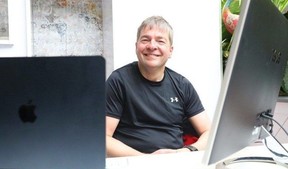Almost 15 years after a near-fatal accident, Robert Wein still wants to help the public understand ‘invisible’ brain injuries.

Article content
Almost 15 years after he suffered a near-fatal brain injury in a terrifying bicycle accident, Ottawa’s Robert Wein has launched a not-for-profit organization aimed at helping the public understand “invisible” brain injuries.
Wein was a federal government procurement specialist, triathlete and scuba diver when a 45-year-old driver plowed into him and four other cyclists on March Road early on the morning of July 19, 2009.
Advertisement 2
Story continues below
Article content
The cyclists — they came to be known as the Kanata 5 — were in a marked bike lane. The driver, Sommit Luangpakham, would tell an Ottawa courtroom he fell asleep at the wheel.
The most seriously injured of the group, Wein had a collapsed lung, broken ribs and a severe brain injury.
He was kept in a medically induced coma for three weeks to manage the swelling in his brain; doctors were unsure whether he would ever regain consciousness.
Wein survived and spent more than six months in rehab, learning how to sit, balance and walk using newly forged brain networks. But he has been unable to return to work — Wein is medically retired — or engage in his former athletic pursuits.
He uses a disability scooter and walker to navigate the world.
Wein used to pour his energy into raising money for brain-injury related causes through an annual fundraising walk. But the COVID-19 pandemic ended that initiative and he has cast about ever since for a new way to give his life purpose.
It is, he says, the central challenge of living with his brain injury.
“For me, the challenge is moderately simple — to do something that matters,” he says in an email interview, his preferred method of communication.
Article content
Advertisement 3
Story continues below
Article content
“I could go on, but that about sums it up, because I woke up one morning a while ago and decided to do that: something that matters.”
Wein, 53, this year launched a not-for-profit organization, the BrainStrong Network, that seeks to raise awareness about the nature of acquired brain injuries and the challenges involved in living with them.
On the BrainStrong website, Wein blogs about his own experiences and invites readers to ask him questions.
“Ultimately,” he writes, “my goal in opening up about my brain injury is to foster understanding and empathy. By sharing my experiences and answering your questions, I hope to break down the barriers that often surround invisible disabilities.”

Unlike strokes, which follow a common pattern — a right middle cerebral artery (MCA) stroke typically will result in problems on the left side of the body — a severe brain injury is unpredictable.
Wein’s diffuse injury produced a weakened right leg and left arm, double vision and a speech impediment. His short-term memory has also been damaged.
He uses a wide variety of strategies — to-do lists, technology and memory exercises — to overcome his shortcomings.
Advertisement 4
Story continues below
Article content
Wein says it’s easy to get down on himself and to concentrate on the things he’s unable to do since the accident.
But, after a discussion with Kerry Goulet, a former professional hockey player and the founder of the non-profit group StopConcussions, he resolved to change his perspective and focus on the positive.
“I decided to not be self-negative about what I didn’t do, but to do something,” Wein said.
Goulet’s group, StopConcussions, is allied with several former NHL players, including former Ottawa Senators and Ottawa 67’s forward Zenon Konopka, and has agreed to work with Wein to expand the BrainStrong Network.
Wein is hosting a trivia night on Friday, Feb. 7 at 7 p.m. at Danby’s Roadhouse in Richmond to raise funds for BrainStrong.
Andrew Duffy is a National Newspaper Award-winning reporter and long-form feature writer based in Ottawa. To support his work, including exclusive content for subscribers only, sign up here: ottawacitizen.com/subscribe
Recommended from Editorial
Article content


Comments